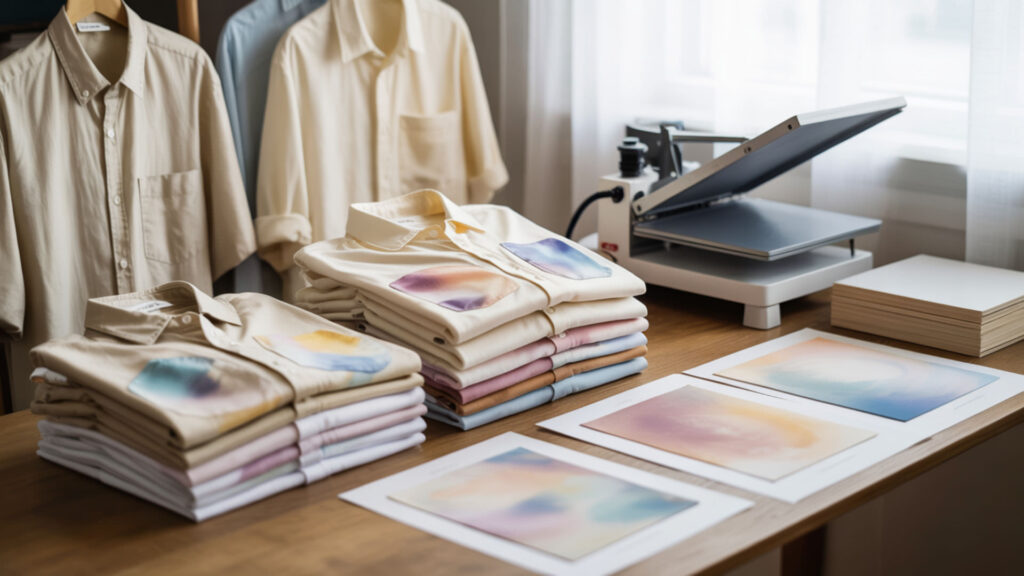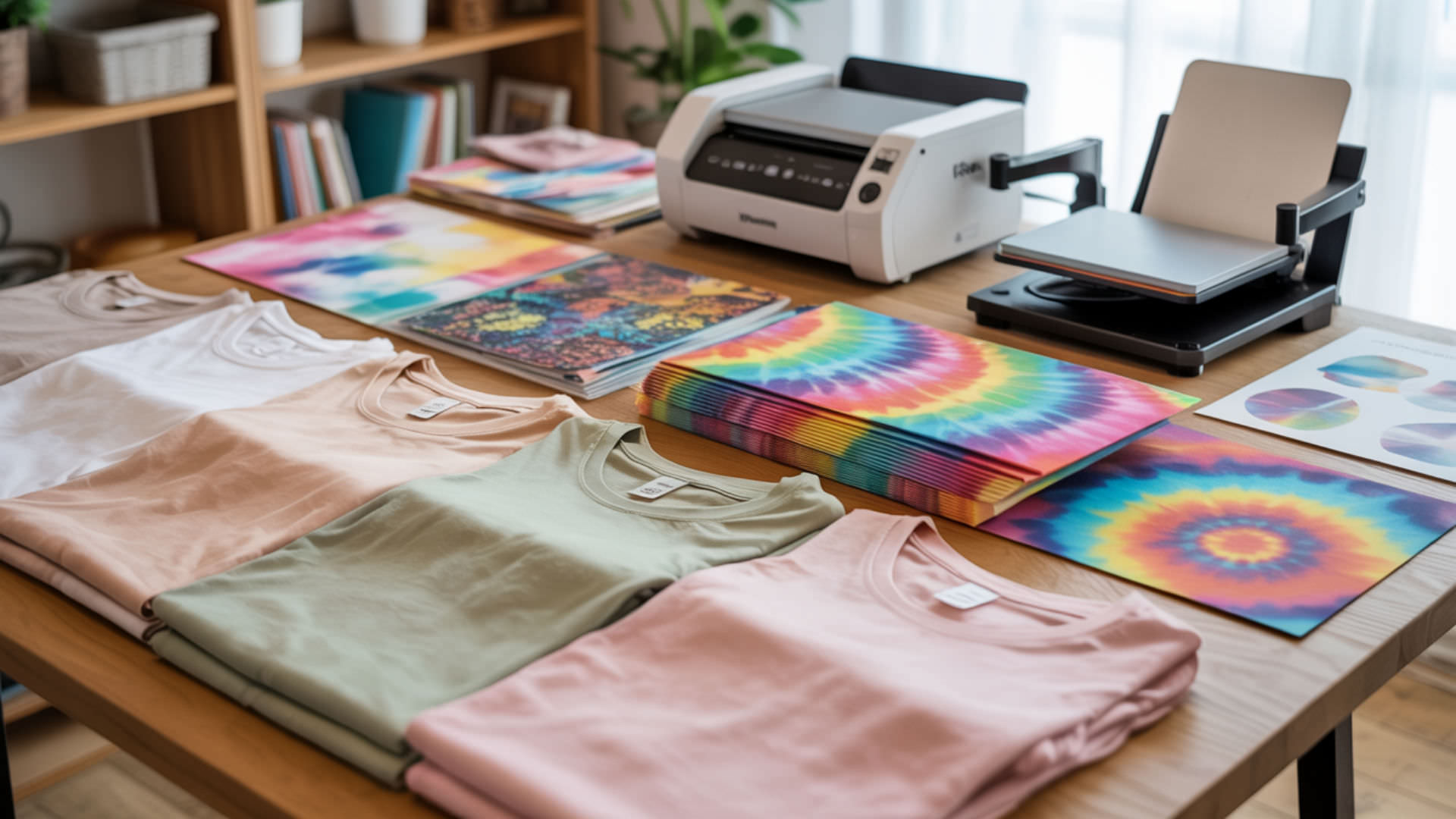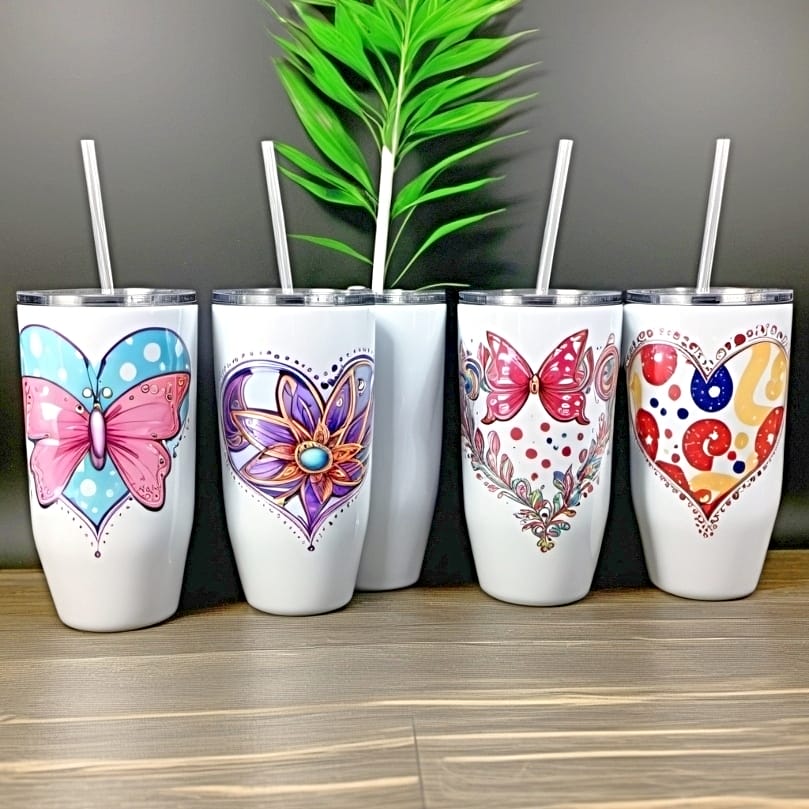Table of Contents
ToggleDark pigments in fabric block sublimation visibility because disperse dyes are translucent—they add color rather than covering what’s beneath. Opacity contrast between the dye and substrate determines whether sublimation appears vibrant or invisible. Because polyester shirts accept sublimation but still require light backgrounds for visibility, our complete sublimation guide explains the chemistry behind these limitations. With proper preparation techniques, dark fabrics can become sublimation-ready through bleaching or intermediate layers.
Key Takeaways
- Disperse dyes require light backgrounds due to their translucent nature—sublimation adds color to fabric rather than covering existing pigments.
- Low opacity contrast causes dull or invisible prints on dark shirts; white or bleached areas create the visibility threshold needed for vibrant results.
- Sublimation HTV or bleach preparation creates light zones on dark polyester where disperse dyes can display their true colors.
Can you sublimate on black and other dark shirts?

You can sublimate on dark shirts, but not directly—dark pigments overpower the translucent disperse dyes, making designs invisible or muddy. Opacity contrast determines the visibility threshold; black fabric provides zero contrast for sublimation colors to appear against. The dye physically bonds to polyester fibers regardless of color, but without light reflection there’s nothing to see. Creating light zones through bleaching or applying white sublimation HTV provides the contrast needed for vibrant results.
Does sublimation show up on black shirts?
Sublimation does not show up on black shirts because chromophores in the dark fabric absorb light that would otherwise reflect your design’s colors. Dark pigments prevent dye visibility unless removed through bleaching or coated with white HTV. The sublimation process technically works—disperse dye gas penetrates polyester fibers and bonds permanently—but the transferred colors remain invisible against the black background. Only lightened or white-coated areas reveal sublimation vibrancy. Dark surfaces have low reflectance and absorb most visible light, which explains why sublimation dyes cannot be seen on black fabrics without a lightened base. [1]
Can you sublimate on black polyester shirts?
Black polyester shirts accept sublimation dye at the molecular level—the bonding occurs identically to white polyester—but the dark color overwhelms translucent sublimation dyes visually. Opacity contrast between dye and fabric determines visibility, and black provides no contrast for colors to display against. The dye exists inside the fiber structure permanently, yet remains invisible because no light reflects back through the dark pigmentation. Bleaching or HTV intermediate layers solve this by creating visible zones.
Can you sublimate on different color shirts?

You can sublimate on different color shirts, but results vary based on dark pigment concentration and opacity contrast with your design colors. Transfer paper must be applied to lighter zones for visibility—any dark areas will mute or completely hide sublimation colors. Light pastels and medium tones work with careful color matching, while dark colors require preparation. Since opacity contrast affects both initial vibrancy and long-term fading appearance, our washing guide explains how to maintain brightness on colored shirts.
Can you use any color shirt for sublimation?
Technically any polyester shirt accepts sublimation, but visible results depend on fabric color and chromophore concentration. More chromophores in dark pigments mean less sublimation visibility—black absorbs nearly all transferred color while white reflects it completely. Light colors (white, cream, pastels) provide optimal contrast; medium colors (light gray, baby blue) tint designs but remain visible; dark colors (navy, black, burgundy) require bleaching or HTV preparation for any visibility.
⫸ Click Here For Best Selling Sublimation Printers And Products ⫷What colors does sublimation work best on?
Sublimation works best on white and light-colored polyester shirts because high opacity contrast allows disperse dyes to display their true colors. White provides the brightest, most accurate results since it reflects all wavelengths of transferred dye color. Pale pastels work well but tint white areas of designs with the shirt’s base color. Any light polyester with 65%+ synthetic content delivers excellent sublimation results without preparation or intermediate layers.
How do you sublimate dark shirts step-by-step?

Sublimation HTV or white glitter HTV creates a polyester surface layer that accepts disperse dyes on otherwise dark fabrics. Press temperature activates dye transfer onto the HTV intermediate layer just as it would onto white polyester. For guidance on selecting ideal shirt types for dark-fabric sublimation projects, our sublimation HTV compatible shirt guide reviews the best options.
- Design your image and mirror/flip horizontally; print onto sublimation transfer paper at 300+ DPI.
- Cut white sublimation HTV to match your design shape; weed excess vinyl from around the design.
- Pre-press dark shirt for 5–10 seconds to remove moisture and wrinkles from the application area.
- Position HTV on shirt with carrier sheet facing up; press at manufacturer’s temperature (typically 305–320°F) for 10–15 seconds.
- Peel carrier sheet according to HTV type (warm or cold peel); allow complete cooling if cold-peel vinyl.
- Align sublimation print face-down on white HTV surface; secure edges with heat-resistant tape.
- Cover with protective paper; press at 375–400°F for 45–60 seconds with medium pressure.
- Remove paper immediately while warm; allow the shirt to cool completely before handling or folding.
How do you bleach dark shirts to prepare for sublimation?

Bleaching dark shirts uses sodium hypochlorite to break down chromophores in fabric dye, creating light sublimation zones where disperse dyes can display vibrantly. Pigment removal exposes the base polyester color (often orange or cream on black shirts) which provides contrast for sublimation. For detailed instructions on safe bleaching ratios, timing, and neutralization steps, our bleaching guide covers the complete process. Bleaching agents act as oxidizers that chemically alter dye molecules, which reduces dark coloration and allows lighter areas to form for sublimation. [2]
How long does it take for bleach to lighten a black shirt?
Sodium hypochlorite begins lightening black fabric within 5–10 minutes, with visible color change appearing as orange or reddish tones rather than gray. More chromophores in densely dyed black fabric require longer bleaching time—expect 30 minutes to one hour for significant lightening. Black dye contains blended red, blue, and yellow pigments; blue and yellow discharge faster than red, leaving warm undertones. Heat activation (sunlight, dryer, heat gun) accelerates the process to 7–15 minutes for spray applications.
How do you lighten a dark shirt for sublimation?
Mix 1:1 ratio bleach and water in a spray bottle for controlled bleach patterns on dark polyester shirts. Spray bottle application allows precise placement of lightened zones where sublimation designs will appear. Apply bleach to desired areas, then activate with heat (sunlight for 7–8 minutes or dryer on high) to accelerate pigment breakdown. Complete the rinse/wash process thoroughly to neutralize remaining sodium hypochlorite before pressing—residual bleach causes yellowing under heat press temperatures.
Why does my sublimation look too dark or muddy on shirts?

Muddy sublimation results from moisture content in fabric causing muted transfers, ghosting from paper movement creating blurry double-images, or dark pigments absorbing transferred color. Moisture trapped in polyester fibers creates steam during pressing that dilutes dye concentration and causes cloudiness. Pre-press for 5–10 seconds to eliminate moisture before applying transfers. Movement during pressing causes ghosting—the shadowed duplicate image that makes designs appear muddy or unfocused.
Can you sublimate over black areas of a design?
Disperse dyes cannot overpower black ink in existing designs because sublimation adds translucent color rather than opaque coverage. Black areas remain black after sublimation—the dye bonds but remains invisible against the dark pigment. Opacity contrast determines visibility; black provides zero contrast for any sublimation color to appear against. Design around black elements rather than over them, or use black sublimation ink to create dark areas that match your design intent.
Can you use sublimation ink on dark colored fabrics?
Sublimation ink physically transfers to dark polyester shirts but produces invisible or severely muted results without preparation. Disperse dyes need high-polyester content (65%+) combined with light-colored surfaces for visible designs. Dark fabrics require intermediate layers (sublimation HTV, white glitter vinyl) or bleach preparation before sublimation produces viewable results. Alternative methods like DTF (direct-to-film) use white ink base layers specifically designed for dark fabric applications.
What colors can you not sublimate on shirts?
You cannot sublimate directly on black, navy, charcoal, burgundy, or other very dark colors because dark pigments block sublimation gas entirely—translucent dyes need light backgrounds to reflect color. Any fabric darker than medium gray requires bleaching or HTV preparation for visible results. Navy and dark forest green may show some color on very bright designs, but results remain significantly muted. True black absorbs essentially 100% of sublimation color, producing completely invisible transfers.
What color material can you sublimate on effectively?
Light polyester shirts in white, cream, pastels, and pale tones provide ideal clarity and vibrancy for sublimation without any preparation. White delivers the most accurate color reproduction since no base tint affects the transferred design. Light gray, baby blue, pale pink, and similar shades work well but tint white areas of designs. Sublimation HTV provides a workaround on non-white shirts by creating a white polyester surface layer that accepts dyes regardless of the underlying fabric color.
Ready to Sublimate on Dark Shirts?
Dark shirt sublimation becomes achievable with sublimation HTV intermediate layers or bleach preparation that creates light zones for disperse dyes to display vibrantly. The proper press temperature activates dye transfer onto HTV surfaces just as effectively as direct polyester application. Master these techniques to expand your sublimation capabilities beyond white fabrics into dramatic dark-on-light contrast designs that stand out from standard sublimation offerings.
Frequently Asked Questions
Can you sublimate directly on black shirts without any pretreatment?
No—sublimating directly on black shirts produces invisible results because dark pigments absorb all transferred color. The dye bonds inside polyester fibers identically to white fabric, but without light reflection there’s nothing visible. You must create light zones through bleaching or apply sublimation HTV intermediate layers before sublimation produces visible results on black polyester. No amount of increased temperature, time, or pressure changes this fundamental opacity limitation.
Do dark sublimation shirts fade or change more after washing than light shirts?
Dark pigments may cause greater appearance of fading on sublimated areas because any color fastness loss becomes more visible against high-contrast backgrounds. Light shirts show sublimation fading as general color softening, while dark shirts reveal it as increasingly washed-out contrast zones. Moisture content during washing affects print clarity even post-wash; follow cold water, gentle cycle protocols. HTV-based sublimation on dark shirts may show edge lifting over time if not properly pressed initially.
Can you mix bleach and sublimation designs on the same dark shirt?
Yes—bleaching creates light zones specifically for sublimation placement while leaving surrounding dark fabric intact for dramatic contrast effects. Popular techniques include bleach splatter patterns with sublimation designs positioned on lightened areas, or bleached center panels surrounded by dark sleeves. Ensure complete neutralization and drying of bleached areas before sublimation pressing. The combination produces unique results impossible through either technique alone.
Can you sublimate on very dark colors like navy or charcoal?
Navy and charcoal produce severely muted sublimation results without preparation—slightly better than black but still inadequate for vibrant designs. Very bright neon sublimation colors may show faintly on navy, but accurate color reproduction is impossible. Charcoal provides marginally more visibility than black due to gray undertones that reflect some light. For professional results on any dark color beyond medium gray, use bleach preparation or sublimation HTV intermediate layers.
Why do some areas of my sublimation design look more faded on dark shirts?
Uneven fading on dark shirt sublimation typically indicates inconsistent bleach application, moisture content variation across the fabric, or uneven HTV adhesion creating different dye acceptance zones. Bleach concentration varies during spray application—lighter areas absorbed more solution and lightened further. Pre-press thoroughly to eliminate moisture pockets that cause localized muting. Check HTV for complete adhesion before sublimating; lifted edges accept less dye and appear faded compared to fully bonded areas.
⫸ Click Here For Best Selling Sublimation Printers And Products ⫷













